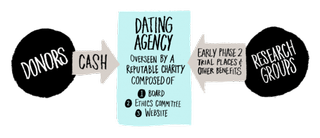
Trials Funded by Rich Patients Could Help Find Cures for Us All

This article was originally published on The Conversation. The publication contributed this article to Live Science's Expert Voices: Op-Ed & Insights.
Disease can affect any person, rich or poor. While your bank balance can’t really protect you from getting sick, it could potentially buy you – and many other patients – access to a better treatment for your disease. A new “plutocratic proposal” put forward by Alexander Masters enlists wealthy patients to both fund and participate in clinical trials alongside other patients who could benefit from an otherwise untested new treatment.
Developing a new treatment can be a long and expensive process that leaves promising new treatments languishing in a lab freezer. The translation of a treatment from the lab bench into humans can cost millions or billions of dollars. There are few grants that suit this type of research translation – and private donations, while very gratefully received, rarely add up to the right numbers.
If it is a disease that affects many, like cancer, then huge organisations, such as Cancer Research UK, can help lobby for grants to be directed towards clinical trials that will, on average, help more people. In such economic circumstances, those with rare diseases have a hard case to make for money to be directed their way.
This funding situation is only expected to get worse. For instance, the Canadian Institutes for Health Research (CIHR), one of Canada’s largest funding bodies for health sciences, is debating whether clinical trials should be funded at all. They argue that funding a single clinical trial with a price tag of C$2m (US$1.8m) – the approximate cost for an academic researcher to run their own early-stage study – would mean that many other research labs who might otherwise expect to receive smaller grants to support their basic research would miss out.
The main alternative path for finding funds to take that first step into a clinical trial pairs a researcher with a pharmaceutical company. The industrial partner supplies the necessary funds needed to run the study, as long as they see good potential for a return on their investment. The downside is that researchers usually end up signing away their promising treatment as a condition of the partnership – and ultimately losing control of subsequent returns should the therapy prove to be successful.
With Masters’ proposal, a rich benefactor essentially enables a clinical trial to go ahead that would otherwise have remained unfunded. The idea involves creating a not-for-profit “dating agency” that would match a sick benefactor with a researcher who has a promising new treatment for his or her disease.
Sign up for the Live Science daily newsletter now
Get the world’s most fascinating discoveries delivered straight to your inbox.
The dating agency would have an independent panel of scientists whose job it would be to validate the science behind the therapy. The rich benefactor donates, say, US$2m and both the benefactor and 19 other people suffering from that disease, who could not have afforded to pay a contribution towards such a trial, get a spot on the clinical trial. The framework of the clinical trial – including ethical and regulatory approval – remains unchanged. The only difference is where the funds are coming from.

Most importantly, Masters has shown that this funding approach works. After his close friend Dido Davies died from cancer after receiving traditional treatments that didn’t really help, Masters began exploring new ways to help patients get access to promising new drugs.
In just eight months, he had helped to secure £2m (US$3.2m) to get a new biotherapy for neuroendocrine cancer – Dido’s disease and the one that killed Steve Jobs – into clinical trials. This new biotherapy, a cancer-killing adenovirus developed in Uppsala University in Sweden, had been languishing in a freezer for several years because of a lack of funds.
Masters explains his idea:
There are 100,000 people in the world worth more than £20m (US$32m). According to the medical statistics, between three and five people in every 100,000 will get neuroendocrine cancer. So three to five supremely wealthy people will have the disease. For £1m, I was going to sell one or two of these wealthy individuals a place on the [biotherapy] trial. All the wealthy individuals had to do was pay for the entire trial.
Masters initially held a crowdfunding campaign to raise £200,000 (US$320,000) and generate enough publicity for his idea. As he had hoped, the campaign caught the attention of an American millionaire called Vince Hamilton, who was also suffering from neuroendocrine cancer. He supplied Uppsala University with the remaining funds to start the clinical trial.
Masters now hopes that this model can fund further trials. One of the golden features of his idea is that it shifts the return on clinical trials from profit – the aim of pharmaceutical industry-funded trials – to health. Masters' new idea appears to be a scalable solution that could see plutocratic patients overhauling the currently listless clinical trial funding structure.
Stephanie Swift works for David Stojdl at the Children's Hospital of Eastern Ontario Research Institute, Ottawa.
This article was originally published on The Conversation. Read the original article. Follow all of the Expert Voices issues and debates — and become part of the discussion — on Facebook, Twitter and Google +. The views expressed are those of the author and do not necessarily reflect the views of the publisher. This version of the article was originally published on Live Science.












